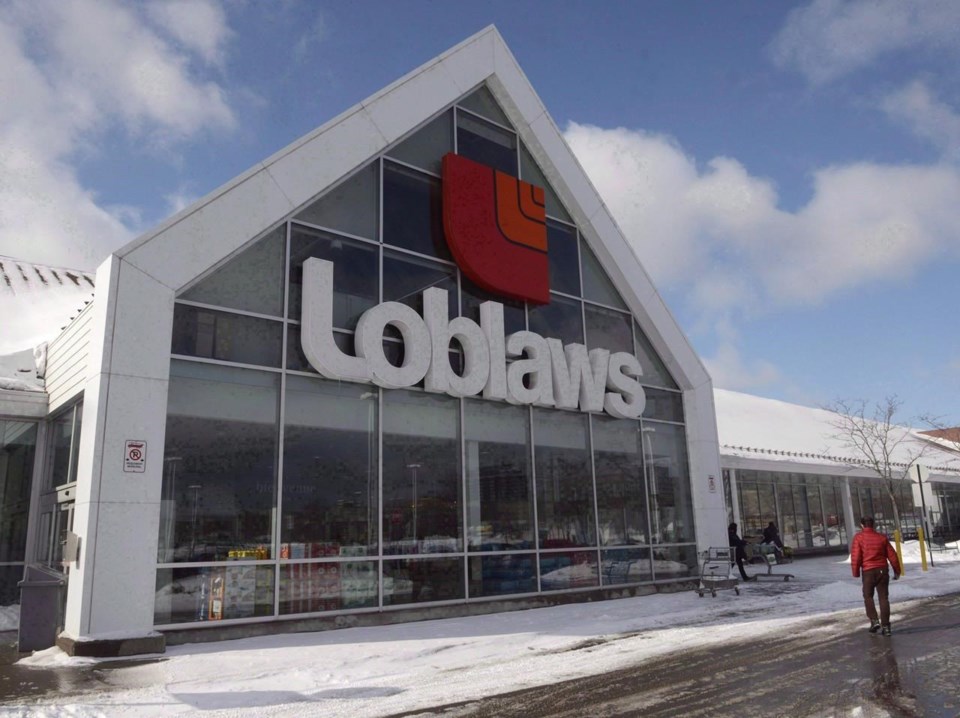Loblaw Cos. Ltd. said it's continuing to expand its footprint of discount stores as consumers trade down after a run of high food inflation.
Loblaw reported its third-quarter profit and revenue rose compared with a year ago, as it said its discount stores saw higher traffic.
"Our Maxi and No Frills stores led the way, generating double-digit growth again this quarter," said chairman Galen Weston on a conference call with analysts.
Between new locations and converting some stores into discount banners, Weston said the company has opened 23 discount stores so far this year. Next year, the company plans to convert 30 more stores and open 40 new locations across the country, he said.
Those conversions will mainly be in Quebec, added CFO Richard Dufresne on the call. Around 60 per cent of the new stores will be Shoppers Drug Marts, and the rest will mostly be discount grocery stores.
Sales of in-house brands like No Name and President's Choice continued to outpace national brands as shoppers favoured lower-priced products, said Loblaw.
Weston said he doesn't see the shift to discount going away any time soon.
"There's no sign of it slowing down in any meaningful way," he said. "Our perspective is that this will continue, you know, for the foreseeable future."
Canadians are trading down and going to discount stores, but also eating more at home to try and save money, which benefits the grocers, said retail analyst Bruce Winder.
“There's definitely some changes here over the last couple of years in the grocery environment, and Loblaw has definitely picked up on that,” he said.
On Wednesday, the parent company of Loblaws and Shoppers Drug Mart reported a profit available to common shareholders of $621 million or $1.95 per diluted share for the 16-week period ended Oct. 7.
The result compared with a profit of $556 million or $1.69 per diluted share in the same quarter a year earlier.
Revenue for the quarter totalled $18.27 billion, up from $17.39 billion in the same quarter last year.
The increase came as food retail same-stores sales rose 4.5 per cent and drug retail same-store sales gained 4.6 per cent, helped by front store same-store sales growth of 1.8 per cent and pharmacy same-store sales growth of 7.4 per cent.
On an adjusted basis, Loblaw said it earned $2.26 per diluted share, up from an adjusted profit of $2.01 per diluted share a year earlier.
The company said its retail gross margin declined as a result of promotions and increased shrink— an industry word for theft — noting that its internal food inflation metric was lower than Canada's food inflation number.
Dufresne said several large global suppliers are still coming to the retailer with higher-than-expected cost increases for next year. In recent quarters, the company has been pointing the finger at large multinational food brands as a driver of rising food costs, but one of Canada’s biggest food supplier industry groups has said suppliers face their own pressures from rising costs.
"The decrease in our food margin is evidence that our costs continue to grow faster than our prices," Dufresne said, but added that "the support of suppliers" is needed for the industry to sustain the momentum of slowing food inflation.
Loblaw and its competitors have been under pressure to stabilize food prices for Canadians. The federal government recently called on them to provide detailed plans to address rising food costs through discounts, promotions and other measures.
Weston said lowering food prices is the company's top priority, and reiterated previous statements that grocers themselves aren't the reason for higher food prices.
"Over the last two months, we have participated actively in discussions with government, shared ideas, and have provided them with the details of the specific actions we have taken," he said.
"As part of these efforts, we are focused on delivering additional value across the basket of 35 items that matter most to customers on a weekly basis."
The coming quarter could show whether these plans are affecting Loblaw’s bottom line, said Winder.
He added that there’s a lot of scrutiny on the company right now, with trust among consumers at an “all-time low.”
The industry is also nearing the completion of a grocery code of conduct meant to provide guidelines for fair dealings between retailers and suppliers. Loblaw recently criticized the code, saying it's concerned it will add $1 billion in extra costs for consumers, a claim that proponents of the code refuted.
On the call, Weston repeated Loblaw's claims that the code could lead to inflationary pressure.
"We've been active in conversations about this code of conduct for a couple of years now," Weston said.
"We continue in those conversations and we'll be working hard to make sure that the code doesn't have any of those unanticipated or unexpected consequences."
It was Weston's last analyst call with the company, as Loblaw previously announced he will step back from day-to-day operations, remaining chairman while European retail executive Per Bank becomes president and CEO.
"Per has spent the past few months getting to know our stores, our store support functions, and our colleagues across the country. This month, he steps fully into the role bringing a wealth of experience and energy," said Weston.
Loblaw shares closed down 2.23 per cent Wednesday, at $120.29.
-- With files from Brett Bundale
This report by The Canadian Press was first published Nov. 15, 2023.
Companies in this story: (TSX:L)
Rosa Saba, The Canadian Press



